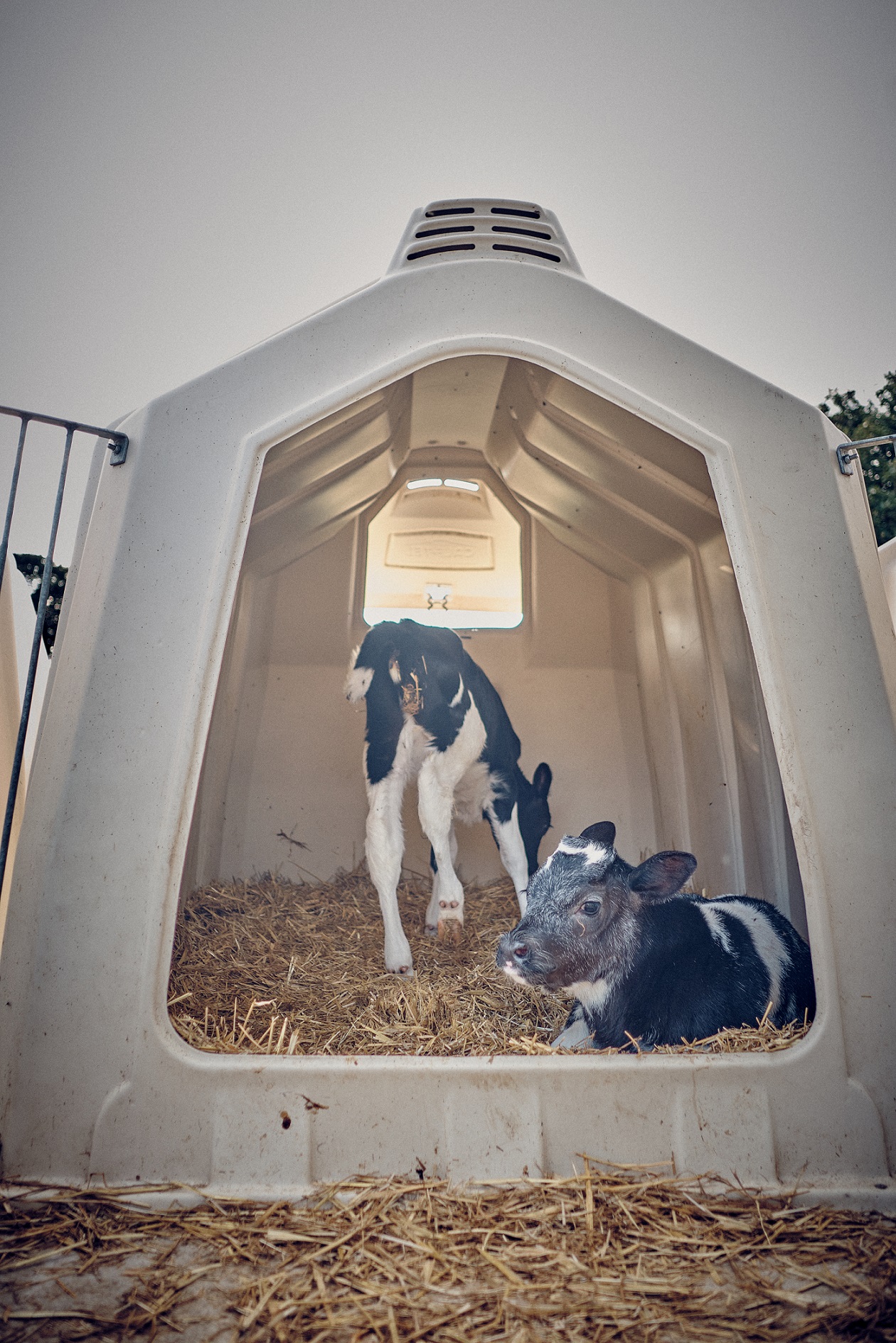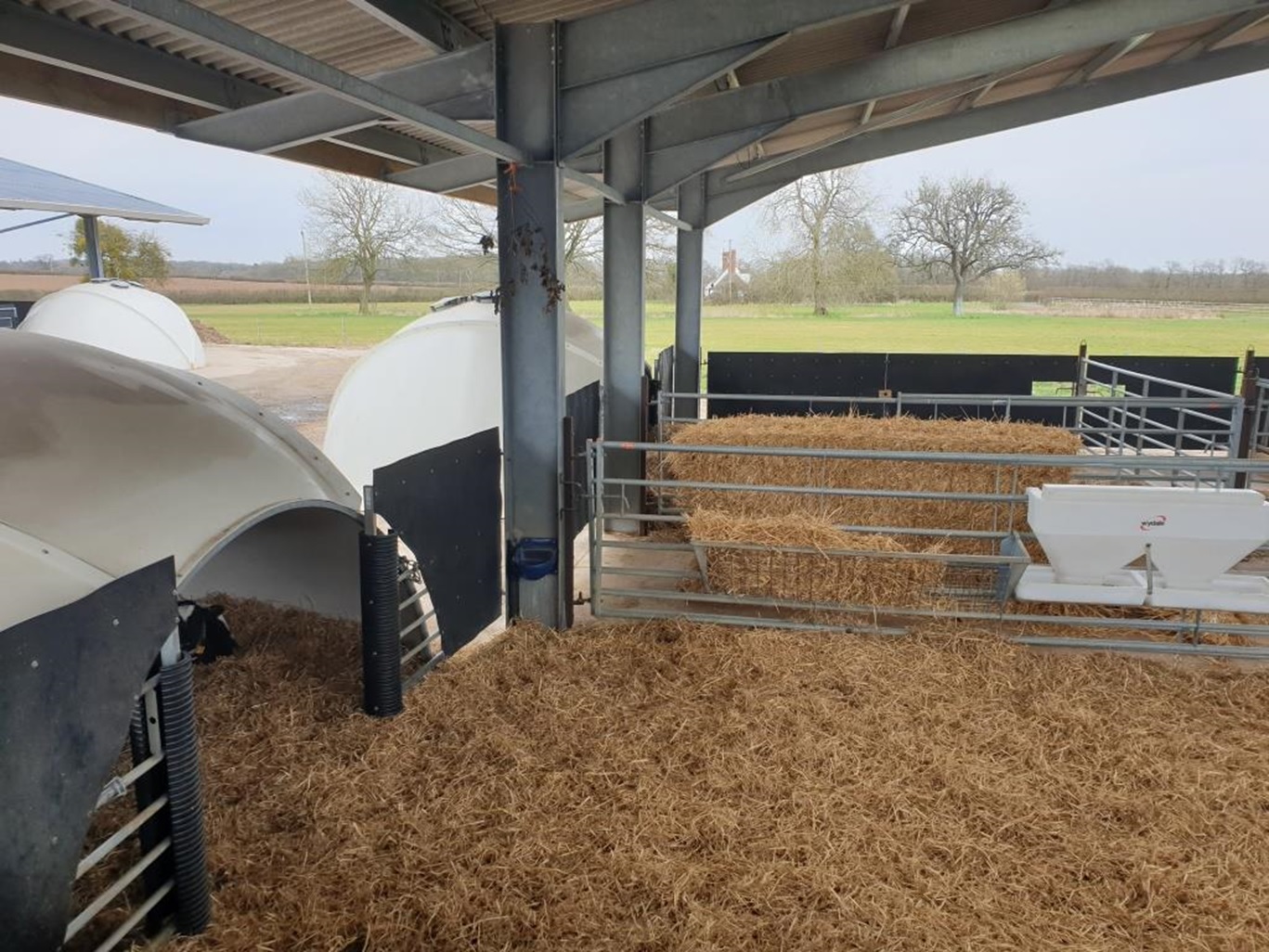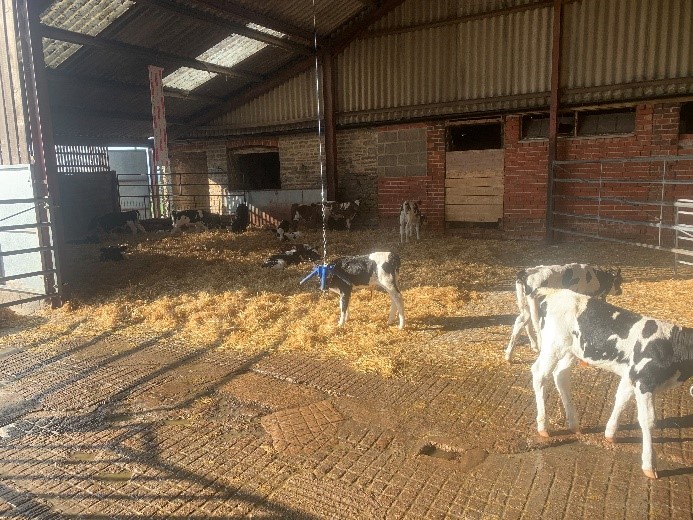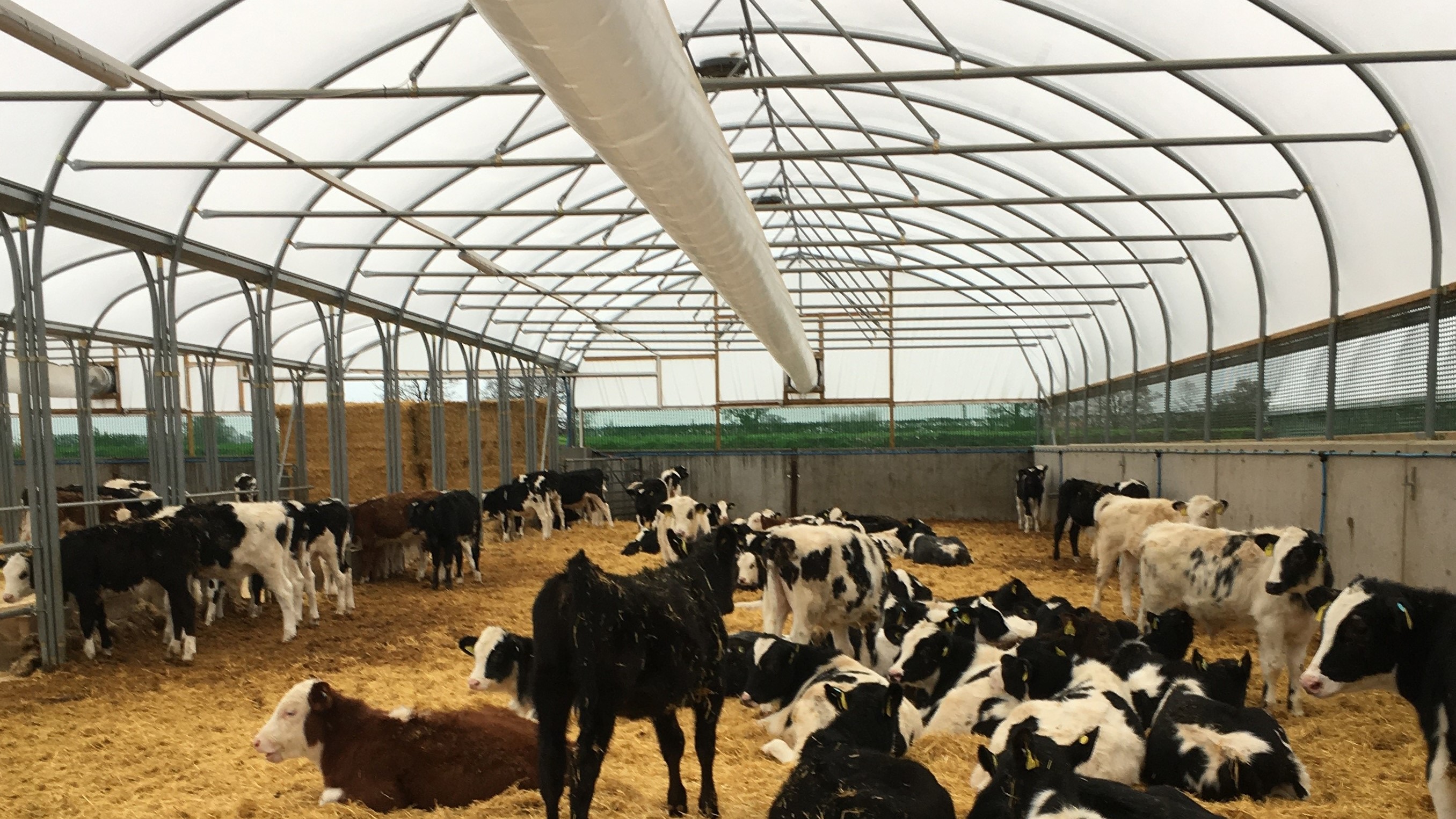- Home
- Knowledge library
- Youngstock housing – Housing systems
Youngstock housing – Housing systems
There are many youngstock housing systems available, and it is important to understand which system will work best on your farm. Here we have identified seven of the main youngstock housing systems, although this is not an exhaustive list.
Housing systems
This webpage looks at seven of the most popular dairy youngstock housing systems available to farmers. Benefits, considerations and factors including disease control, the quality of shelter that they provide and where they are best situated, are provided for each system. The systems are:
- Purpose-built portal frame
- Purpose-built mono pitch
- Individual or paired hutches
- Group hutches or igloos
- General purpose building
- Lightweight structures – such as a polytunnel
- Low-cost or temporary calf structures – such as utilising old buildings or covered bale pens
Purpose-built portal frame
| Factor | Benefits | Consideration |
|---|---|---|
|
Disease control |
Advantageous if run on an all-in and all-out system. Walls and floors are easy to clean and disinfect. Adequate falls and good drainage. Individual/double/small pens allow low disease transmission and can suit all-year-round calving. |
Group housing can allow the spread of disease, particularly when stocked constantly. Construction costs tend to favour larger m2, which significantly increases risk. |
|
Ventilation |
If suitably located, it can obtain maximum benefit from natural ventilation. Easy to fit positive pressure tube ventilation (PPTV). |
Will not ventilate when wind speeds are low, particularly if a high-volume building. Will need mechanical ventilation to compensate for low wind speed days. If the building has large openings in gables or sidewalls, high wind speeds can cause turbulence at pen level, increasing wind chill. |
|
Shelter |
Provides excellent shelter, provided draughts are avoided without limiting access to fresh air. |
The building can exaggerate weather conditions creating wind tunnels or no air flow. Some materials make cold temperatures colder and hot temperatures hotter. |
|
Location |
Good building design can accommodate most locations. |
Choice of location based on, for example, available space or access for vehicles may create compromises on the effectiveness of investment. Some locations can increase biosecurity risk. Impaired natural ventilation. Consider labour requirements. |
|
Hygiene |
The choice of materials for pen walls and pen fittings has a long-term impact. Can achieve good hygiene levels if the building structure is well maintained and drainage is suitable. |
Hygiene can be compromised if the drainage is poor, surfaces are badly maintained and hard to clean. Floor detail is essential as mistakes at installation are seldom repaired. The overall design may be compromised by using large field machinery for mucking out. |
|
Cost |
Calf handling and services for inspection, lighting and automation are readily available with a positive impact on variable costs. Efficient use of bedding with low or no ingress of rainwater. |
Tempting to build a general-purpose building that compromises on calf requirements. Relatively high capital cost |
|
Labour |
Good logistics if well planned. Working inside during harsh weather. Consumables are available at hand. |
Challenging to clean mechanically when not used as an all-in and all-out system. |
Purpose-built mono pitch
| Factor | Benefits | Consideration |
|---|---|---|
|
Disease control |
Advantageous if run on an all-in and all-out system. Walls and floors are easy to clean and disinfect. Adequate floor slopes and good drainage. Easy to create a series of smaller spaces to reduce disease transmission. Suitable for all year round calving with suitable protection. |
Group housing can allow the spread of disease, particularly when stocked constantly. Construction costs tend to favour larger m2, which significantly increases risk. |
|
Ventilation |
If suitably located, it can obtain maximum benefit from natural ventilation. Low-volume air space is beneficial if correctly designed. Easy to fit PPTV. |
Not suitable for an exposed site without protection to the front. |
|
Shelter |
Considerably better than outside housing. |
Open-front designs will always be compromised by prevailing weather conditions, most commonly during the winter months. |
|
Location |
Suitable for most locations. Should be positioned with back to the prevailing wind. Small footprint gives flexibility. |
Less suitable for very exposed sites. |
|
Hygiene |
The choice of materials for pen walls and pen fittings has a long-term impact. Can achieve good hygiene levels if the building structure is well maintained and drainage is suitable. The design allows for the best practice of mucking out/cleaning/disinfecting pens individually at the optimum time rather than having to clean out the whole shed from one end. Easy to run sections as all-in and all-out. |
Floor design is critical; low-cost options are attractive but not sustainable. |
|
Cost |
Cheaper than a portal frame. Self-build kits available. Easy to start small and add capacity later. |
Temptation to cut corners on self-builds that omits important details. |
|
Labour |
Good logistics if well planned. Working inside during harsh weather. Consumables are available at hand. |
Challenging to clean mechanically when not used as an all-in and all-out system. |
Individual/paired hutches
 AHDB
AHDB
| Factor | Benefits | Consideration |
|---|---|---|
|
Disease control |
Good for disease control with limited contact between calves. Relatively easy to clean out. Can be removed from facility for cleaning. Can be easily moved to a clean site. |
Disease can spread if the hutches are not cleaned and disinfected between calves or the ground is poorly drained. Effort is required to inspect calves carefully. Calves not protected from wind/rain are at increased risk of immune suppression. Legal requirement to ensure visual and tactile contact between calves. |
|
Ventilation |
Some hutches have excellent ventilation. |
Check roof outlet on some designs. Some are severely limited. Hutches under roofs or adjacent to buildings can have compromised ventilation. Need to pay attention to significant changes in wind direction. |
|
Shelter |
The inside area is dry and protected from the weather, and outside, the calf can get limited exercise and sunlight. The calf can choose its preferred environment depending on the weather. Good access to clean air. |
External strawed area often uncovered and easily damp. Extra shade may be needed in the summer. Adjacent hutches can cause wind tunnels. Hutch can freeze in cold weather. |
|
Location |
Hutches can be oriented towards the sun or moved to locations that are most suitable according to the season. Can use small areas adjacent to existing facilities. |
Wind chill can occur unless the hutches are protected from all directions. Hutches need to be fixed to avoid movement in high winds. Location needs to be free draining. Most sites require the replacement of the stone/hardcore base periodically to avoid silting up of drainage capacity. Not suitable for exposed sites. |
|
Hygiene |
Synthetic materials are easy to clean and disinfect. Hutches can be moved to clean ground. |
Cleaning is labour-intensive, and cleaning porous bases presents a hygiene challenge. Can be prone to flies in the summer. |
|
Cost |
Cheaper than purpose-built sheds. Expansion can be modular. Modular design allows scale to be increased slowly. Purpose-built gates/feeders/drinkers/covers available. |
Not cheap depending on the source of the hutch and when all set-up costs are considered. Variable costs high per calf. Straw costs per calf can be high. |
|
Labour |
Good work environment when weather is good. |
Staff work outside in all weathers. Feed and water may need transporting some distance. High labour cost. Doesn’t allow for automatic feeding. |
Group hutches/igloos
 AHDB
AHDB
| Factor | Benefits | Consideration |
|---|---|---|
|
Disease control |
Good for disease control with limited contact between small groups of calves. Small groups are better than large groups. Typically, good access to clean air. Easy to run each igloo/hutch as all-in and all-out. Can be removed for cleaning. |
Disease can spread if igloos are not cleaned and disinfected thoroughly and the bases are not free draining. Drainage is a huge consideration. Group housing can lead to the spread of disease. Effort is required to inspect calves carefully. |
|
Ventilation |
Dependent on natural ventilation and adjustments to vents. Typical igloo systems work well. Area outside the igloos often under a separate roof cover. |
Some designs of group hutches restrict ventilation. |
|
Shelter |
The inside area is dry and protected from the weather, and outside, the calves can get limited exercise and sunlight. The calves can choose their preferred environment depending on the weather. With igloos holding 4–15 calves, there is an opportunity for social interaction with other calves. |
Outside exercise areas can become very damp. Some designs have a wide tall-door area that increases the risk of wind chill inside. Outside areas can be a poor-quality environment. |
|
Location |
Hutches can be oriented towards the sun or moved to locations that are most suitable according to the season.
|
Poor location can expose calves to high wind speeds. Igloos need fixing to the ground. Location needs to be free draining. Not suitable for exposed sites. |
|
Hygiene |
Synthetic materials are easy to clean and disinfect. Hutches can be moved to clean ground. |
Cleaning is labour intensive and cleaning porous bases presents a hygiene challenge. Drainage is a major weakness. Prone to flies in the summer. |
|
Cost |
Some systems are cheaper than a purpose-built facility. Expansion can be staged. Variety of sizes to choose from. |
Many systems are similar costs-per-calf compared with fixed buildings. Running costs can be high due to labour and bedding. High labour cost. |
|
Labour |
Suited for group feeding system. Better working environment than being totally outside. |
Staff work outdoors in all weather. High labour cost. |
General-purpose building
 AHDB
AHDB
| Factor | Benefits | Consideration |
|---|---|---|
|
Disease control |
Suitable for all-in and all-out. |
A standard flat floor can be a major disadvantage for calf rearing by creating poor drainage. Building size can lead to the temptation to have mixed ages of animals, which greatly increases the risk of disease. Increased risk of cold stress in large-volume concrete and steel structures. |
|
Ventilation |
Ventilation can easily be improved with the addition of PPTV, which can be removed later. |
Often too much air volume for young calves with high eaves height. Draughts and cold zones, and poor ventilation is common. |
|
Shelter |
Provides excellent shelter, provided draughts are avoided without limiting access to fresh air. |
Modifications may be required to reduce drafts. |
|
Location |
Can provide flexibility with building use for block-calving herds. |
|
|
Hygiene |
The choice of materials for pen walls and pen fittings has a long-term impact. Can achieve good hygiene levels if the building structure is well-maintained and drainage is suitable. Good logistics if well planned. |
Hygiene can be compromised if the drainage is poor, surfaces are badly maintained and hard to clean. Floor slopes and drains finish is vital. The overall design may be compromised by using large field machinery for mucking out. Cleaning individual pens is a problem. Unlikely to have channels/drains suited for single/double pens. |
|
Cost |
Initial capital cost can be high. |
Low ongoing maintenance cost. Can be used for other purposes and may suit block-calving herds. |
|
Labour |
Working inside during harsh weather. Consumables are available at hand. |
Challenging to clean mechanically when not used as an all-in and all-out system. Design can lead to mechanical cleaning across pens. |
Lightweight structures
 Jamie Robertson.jpg) Jamie Robertson
Jamie Robertson

| Factor | Benefits | Consideration |
|---|---|---|
|
Disease control |
Can provide discrete-housed conditions for small groups of animals. Variable sizes mean suited for all-in and all-out requirements. |
Floor conditions are critical. Respiratory health is sometimes an increased risk. Very dependent on the internal layout. |
|
Ventilation |
Simple structure to manage. |
Long polytunnels can suffer from restricted air movements. Reliant on sidewall ventilation, with attendant draught risk. Minimal outlet ventilation. |
|
Shelter |
Can be good, and a low-profile building means that the structure can sit low in the environment. |
Not suitable for exposed sites without additional protection from the wind. |
|
Location |
Fairly flexible. The type and design of passive ventilation in the structure can be maximised by consideration of the predominant wind direction. |
Must be sited in dry, well-drained areas. Solar radiation can lead to a temperature increase within the structure. Care is required with the selection of cladding colour. |
|
Hygiene |
Structure size can be made highly appropriate to group sizes to run all-in and all-out. A suitable structure for batch-calving herds. |
Depending on the materials used in construction, it can be hard to clean and disinfect. A deep clean protocol is needed for non-concrete floors. |
|
Cost |
Lower initial capital cost. |
The costs associated with concrete flooring, pens and fittings, water and power supply must be considered. Be realistic about maintenance and repair costs and durability. |
|
Labour |
Good shelter from inclement weather for staff. |
Higher labour requirements for managing fittings and more manual handling than buildings with machine access. |
Low-cost or temporary calf structures
| Factor | Benefits | Consideration |
|---|---|---|
|
Disease control |
A small building or structure can naturally limit group size. Can be single use. Can be used for rapid interventions when, for example, biosecurity issues arise. Can be used to facilitate deep cleaning of main calf house facilities. |
Can be more challenging due to nature of installation. Should be disposable or of a material that can be completely cleaned before re-use. |
|
Ventilation |
Can use natural ventilation when located outdoors. PPTV can be used in temporary structures and reused elsewhere. |
In some existing buildings, ventilation may require improvement. Can be difficult to ventilate naturally without draughts. |
|
Shelter |
Basic structures can be easy to manage. |
Layouts can be inflexible. Can be exposed to extreme weather. Need to be realistic about losses to environmental factors. |
|
Location |
Flexibility on the location. |
Not suited to exposed sites. |
|
Hygiene |
Can be located on clean ground promptly. Straw bales make good temporary pen dividers but should be changed between batches of calves.
|
Less likely to have cleanable surfaces. Drainage unlikely to be suitable. Stone walls will need rendering. May prove difficult to clean out mechanically. If bales are used, they should be changed between batches of calves. |
|
Cost |
Minimal initial financial outlay. |
Be cautious about the additional costs required in time and feed efficiency. |
|
Labour |
Variable |
Labour intensive on daily routines. Labour is required to keep all the various parts of the structures working effectively and to clean and disinfect thoroughly. |
Read more about youngstock housing
Legislation and market requirements
Temperature, humidity and ventilation
Housing layout and construction
Designing housing to feed calves with ease

